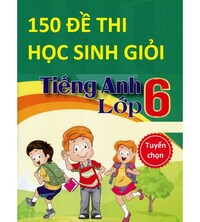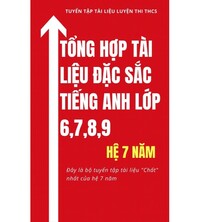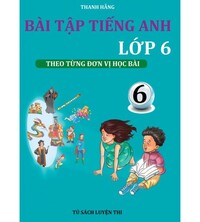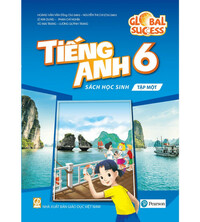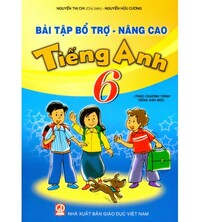8.3 Reading and vocabulary - Unit 8. Talking to the world – Tiếng Anh 6 – English Discovery
Tổng hợp bài tập và lý thuyết phần 8.3 Reading and vocabulary - Unit 8. Talking to the world - SGK tiếng Anh 6 – English Discovery
Bài 1
1. In groups, read through Part 1 and 2 of the text. Choose the best heading for each part. There are more headings than you may need.
(Theo nhóm, đọc hết Phần 1 và 2 của văn bản. Chọn tiêu đề tốt nhất cho mỗi phần. Có nhiều tiêu đề hơn bạn có thể cần.)
a. Chee’s Story (câu chuyện của Chee)
b. H’Mong People (người H'Mong)
c. Sapa
d. ‘Thank you, Sapa’ (Cảm ơn, Sa Pa)
Learning English in Sa Pa
Part 1
Chee*, a 28-year-old H'Mong woman in Sa Pa, set up a company called “Thank you, Sa Pa” to train poor children as tour guides. She hopes to free local girls from being illiterate home helpers. Traditionally, many H'Mong people believe that daughters should work, and going to school is only for the sons.
Part 2
At the age of 11, Chee often joined other children in a spot in front of a rock church, one of the most popular tourist attractions in Sa Pa. The tourists did not understand her so she decided to learn English.
The number of tourists in Sa Pa increased at the beginning of the 2000s. Many of them were willing to sit down and teach local children some basic English. Chee learned a lot from them and soon she could communicate in English.
(* the real names of the woman and her company have been changed to protect their identity)
Phương pháp giải:
Tạm dịch:
Học tiếng Anh ở Sa Pa
Phần 1
Chee *, 28 tuổi, một phụ nữ H’Mông ở Sa Pa, thành lập công ty “Cảm ơn Sa Pa” để đào tạo hướng dẫn viên du lịch cho trẻ em nghèo. Cô hy vọng có thể giải thoát các cô gái địa phương không phải là những người giúp việc nhà mù chữ. Theo truyền thống, nhiều người H'Mông cho rằng con gái phải đi làm, con trai mới được đi học.
Phần 2
Năm 11 tuổi, Chee thường cùng những đứa trẻ khác đến một chỗ trước nhà thờ đá, một trong những điểm thu hút khách du lịch nhất ở Sa Pa. Du khách không hiểu cô nên cô quyết định học tiếng Anh.
Lượng khách du lịch đến Sa Pa tăng vào đầu những năm 2000. Nhiều người trong số họ sẵn sàng ngồi xuống và dạy cho trẻ em địa phương một số tiếng Anh cơ bản. Chee đã học được rất nhiều điều từ họ và chẳng bao lâu nữa cô ấy có thể giao tiếp bằng tiếng Anh.
(* tên thật của người phụ nữ và công ty của cô ấy đã được thay đổi để bảo vệ danh tính của họ)
Lời giải chi tiết:
Part 1 – d. ‘Thank you, Sapa’ (Cảm ơn, Sa Pa)
Part 2 – a. Chee’s Story (câu chuyện của Chee)
Bài 2
2. Read Part 1 again. In pairs, mark the sentences ✓ (right), x (wrong) or ? (doesn’t say).
(Đọc lại Phần 1. Theo cặp, đánh dấu các câu ✓ (đúng), x (sai) hoặc? (không nói).)
1. ‘Thank you, Sapa’ is a company owned by Chee.
2. The company helps to train childen to be tour guides for free.
3. Tradionally, education in Sapa was only for boys, not girls.
Lời giải chi tiết:
| 1. ✓ | 2. ? | 3. ✓ |
1. ✓
‘Thank you, Sapa’ is a company owned by Chee.
( ‘Thank you, Sapa’ là công ty do Chee làm chủ.)
2. ?
The company helps to train childen to be tour guides for free.
(Công ty hỗ trợ đào tạo miễn phí các em trở thành hướng dẫn viên du lịch.)
3. ✓
Tradionally, education in Sapa was only for boys, not girls.
(Theo truyền thống, giáo dục ở Sapa chỉ dành cho trẻ em trai, không phải trẻ em gái.)
Bài 3
3. Read Part 2 again. In pairs, take turn to ask and answer the following question.
(Đọc lại Phần 2. Theo cặp, lần lượt hỏi và trả lời câu hỏi sau.)
1. When did more tourists come to Sapa?
2. Why did Chee learn English?
3. Could Chee speak English fluently before the age of 11?
4. Who did she learn English from?
Lời giải chi tiết:
1. At the beginning of the the 2000s.
2. Because the tourists did not understand her.
3. No. She could only speak a little Vietnamese.
4. She learnt English/ picked up English from foreign visitors.
Bài 4
4. Study the Vocabulary box. Which words/phrases can you find in the texts?
(Nghiên cứu hộp Từ vựng. Bạn có thể tìm thấy những từ / cụm từ nào trong văn bản?)

Lời giải chi tiết:
“illiterate”, “ethnic language”, “basic sentences”, “words”, “speak a little Vietnamese”, “communicate”
Bài 5
5. Complete the sentences below using the correct form of words/ phrases in the Vocabulary Box.
(Hoàn thành các câu bên dưới bằng cách sử dụng dạng đúng của từ / cụm từ trong Ô Từ vựng.)
1. Your _______ is the language that you learn at home when you're a child.
2. Some children in mountainous areas are still _______ as they are not able to read or write.
3. After five years of learning English as a _______ the little girl is now able to use English to _______ with foreign visitors.
4. John: “Hoa, help me! | don’t understand what Nam is saying because I could only _______
5. All the _______ in this sentence are new to me. I cannot understand what it means.
Lời giải chi tiết:
1. Native language
2. Illiterate
3. Foreign laguage/ communicate
4. Speak a little Vietnamse
5. Words
Bài 6
6. Use the questions below to interview at least three friends. Report the findings to the whole class.
(Sử dụng các câu hỏi dưới đây để phỏng vấn ít nhất ba người bạn. Báo cáo kết quả cho cả lớp.)
1. When did you start to learn English?
2. Why did you learn it?
3. Where did you learn it?
4. What do you like the most when learning English?
5.Is there any other foreign language you also like to learn?
Lời giải chi tiết:
1. I started to learn English 5 years ago
2. I learned it so that I can have the oppoturnity to get accepted into prestigous university and to have well-payed job
3. I learned it at school
4. I like Speaking the language.
5. I also like Chinese and Japanese.
Search google: "từ khóa + timdapan.com" Ví dụ: "8.3 Reading and vocabulary - Unit 8. Talking to the world – Tiếng Anh 6 – English Discovery timdapan.com"
